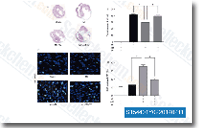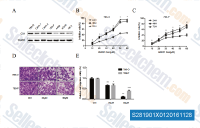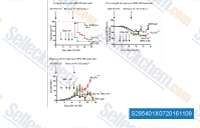
- Bioactive Compounds
- By Signaling Pathways
- PI3K/Akt/mTOR
- Epigenetics
- Methylation
- Immunology & Inflammation
- Protein Tyrosine Kinase
- Angiogenesis
- Apoptosis
- Autophagy
- ER stress & UPR
- JAK/STAT
- MAPK
- Cytoskeletal Signaling
- Cell Cycle
- TGF-beta/Smad
- Compound Libraries
- Popular Compound Libraries
- Customize Library
- Clinical and FDA-approved Related
- Bioactive Compound Libraries
- Inhibitor Related
- Natural Product Related
- Metabolism Related
- Cell Death Related
- By Signaling Pathway
- By Disease
- Anti-infection and Antiviral Related
- Neuronal and Immunology Related
- Fragment and Covalent Related
- FDA-approved Drug Library
- FDA-approved & Passed Phase I Drug Library
- Preclinical/Clinical Compound Library
- Bioactive Compound Library-I
- Bioactive Compound Library-II
- Kinase Inhibitor Library
- Express-Pick Library
- Natural Product Library
- Human Endogenous Metabolite Compound Library
- Alkaloid Compound LibraryNew
- Angiogenesis Related compound Library
- Anti-Aging Compound Library
- Anti-alzheimer Disease Compound Library
- Antibiotics compound Library
- Anti-cancer Compound Library
- Anti-cancer Compound Library-Ⅱ
- Anti-cancer Metabolism Compound Library
- Anti-Cardiovascular Disease Compound Library
- Anti-diabetic Compound Library
- Anti-infection Compound Library
- Antioxidant Compound Library
- Anti-parasitic Compound Library
- Antiviral Compound Library
- Apoptosis Compound Library
- Autophagy Compound Library
- Calcium Channel Blocker LibraryNew
- Cambridge Cancer Compound Library
- Carbohydrate Metabolism Compound LibraryNew
- Cell Cycle compound library
- CNS-Penetrant Compound Library
- Covalent Inhibitor Library
- Cytokine Inhibitor LibraryNew
- Cytoskeletal Signaling Pathway Compound Library
- DNA Damage/DNA Repair compound Library
- Drug-like Compound Library
- Endoplasmic Reticulum Stress Compound Library
- Epigenetics Compound Library
- Exosome Secretion Related Compound LibraryNew
- FDA-approved Anticancer Drug LibraryNew
- Ferroptosis Compound Library
- Flavonoid Compound Library
- Fragment Library
- Glutamine Metabolism Compound Library
- Glycolysis Compound Library
- GPCR Compound Library
- Gut Microbial Metabolite Library
- HIF-1 Signaling Pathway Compound Library
- Highly Selective Inhibitor Library
- Histone modification compound library
- HTS Library for Drug Discovery
- Human Hormone Related Compound LibraryNew
- Human Transcription Factor Compound LibraryNew
- Immunology/Inflammation Compound Library
- Inhibitor Library
- Ion Channel Ligand Library
- JAK/STAT compound library
- Lipid Metabolism Compound LibraryNew
- Macrocyclic Compound Library
- MAPK Inhibitor Library
- Medicine Food Homology Compound Library
- Metabolism Compound Library
- Methylation Compound Library
- Mouse Metabolite Compound LibraryNew
- Natural Organic Compound Library
- Neuronal Signaling Compound Library
- NF-κB Signaling Compound Library
- Nucleoside Analogue Library
- Obesity Compound Library
- Oxidative Stress Compound LibraryNew
- Plant Extract Library
- Phenotypic Screening Library
- PI3K/Akt Inhibitor Library
- Protease Inhibitor Library
- Protein-protein Interaction Inhibitor Library
- Pyroptosis Compound Library
- Small Molecule Immuno-Oncology Compound Library
- Mitochondria-Targeted Compound LibraryNew
- Stem Cell Differentiation Compound LibraryNew
- Stem Cell Signaling Compound Library
- Natural Phenol Compound LibraryNew
- Natural Terpenoid Compound LibraryNew
- TGF-beta/Smad compound library
- Traditional Chinese Medicine Library
- Tyrosine Kinase Inhibitor Library
- Ubiquitination Compound Library
-
Cherry Picking
You can personalize your library with chemicals from within Selleck's inventory. Build the right library for your research endeavors by choosing from compounds in all of our available libraries.
Please contact us at info@selleckchem.com to customize your library.
You could select:
- Antibodies
- Bioreagents
- qPCR
- 2x SYBR Green qPCR Master Mix
- 2x SYBR Green qPCR Master Mix(Low ROX)
- 2x SYBR Green qPCR Master Mix(High ROX)
- Protein Assay
- Protein A/G Magnetic Beads for IP
- Anti-DYKDDDDK Tag magnetic beads
- Anti-DYKDDDDK Tag Affinity Gel
- Anti-Myc magnetic beads
- Anti-HA magnetic beads
- Poly DYKDDDDK Tag Peptide lyophilized powder
- Protease Inhibitor Cocktail
- Protease Inhibitor Cocktail (EDTA-Free, 100X in DMSO)
- Phosphatase Inhibitor Cocktail (2 Tubes, 100X)
- Cell Biology
- Cell Counting Kit-8 (CCK-8)
- Animal Experiment
- Mouse Direct PCR Kit (For Genotyping)
- New Products
- Contact Us
Cannabinoid Receptor Inhibitors/Activators | Agonists | Antagonists | Modulators
Cannabinoid Receptor Products
- All (21)
- Cannabinoid Receptor Inhibitor (1)
- Cannabinoid Receptor Antibodies (2)
- Cannabinoid Receptor Activator (1)
- Cannabinoid Receptor Antagonists (7)
- Cannabinoid Receptor Agonists (8)
- Cannabinoid Receptor Modulators (2)
- New Cannabinoid Receptor Products
| Cat.No. | Product Name | Information | Product Use Citations | Product Validations |
|---|---|---|---|---|
| S1544 | AM1241 | AM-1241 is a selective cannabinoid CB2 receptor agonist with Ki of 3.4 nM, exhibits 82-fold selectivity over CB1 receptor. |

|
|
| S2819 | AM251 | AM251 block the inhibitory effects of endocannabinoids and synthetic cannabinoid agonists on transmitter release through an action at presynaptic cannabinoid 1 receptors in brain. |

|
|
| S3021 | Rimonabant (SR141716) | Rimonabant (SR141716) is a selective antagonist of CB1 with IC50 of 13.6 nM and EC50 of 17.3 nM in hCB1 transfected HEK 293 membrane. Rimonabant is also a dual inhibitor of acyl CoA:cholesterol acyltransferases(ACAT) 1 and 2 and inhibits mycobacterial MmpL3. | ||
| S8012 | Otenabant (CP-945598) HCl | Otenabant (CP-945598) HCl is a potent and selective cannabinoid receptor CB1 antagonist with Ki of 0.7 nM, exhibits 10,000-fold greater selectivity against human CB2 receptor. Phase 1. | ||
| S2854 | BML-190 | BML-190 (IMMA) is a selective cannabinoid CB2 receptor inverse agonist with Ki of 435 nM, with 50-fold selectivity over CB1 receptor. |

|
|
| S8033 | 6-Iodopravadoline (AM630) | 6-Iodopravadoline (AM630) is a selective cannabinoid CB2 receptor antagonist with Ki of 31.2 nM. | ||
| S2778 | GW842166X | GW842166X is a potent and highly selective agonist of cannabinoid receptor CB2 receptor with EC50 of 63 nM, shows no significant activity at CB1 receptor. Phase 2. | ||
| S1534 | Org 27569 | Org 27569 is an allosteric modulator of cannabinoid CB1 receptor, induces a CB1 receptor state that is characterized by enhanced agonist affinity and decreased inverse agonist affinity. | ||
| S8017 | WIN 55, 212-2 mesylate | WIN 55,212-2 Mesylate ((R)-(+)-WIN 55212) is a potent cannabinoid (CB) receptor agonist with Ki of 3.3 nM and 62.3 nM for human recombinant CB2 and CB1, respectively. WIN 55,212-2 Mesylate regulates Glutamate transmission. | ||
| E4945 | Pregnenolone monosulfate sodium | Pregnenolone monosulfate sodium, a sodium salt form of pregnenolone monosulfate, is an active neurosteroid and a precursor of all steroid hormones. It functions act as a potent endogenous allosteric signal-specific inhibitor of CB1 receptors, reducing psychoactive effects associated with Δ9-tetrahydrocannabinol (THC). | ||
| E0458 | RTICBM-189 | RTICBM-189 is a potent, brain-penetrant allosteric modulator of the cannabinoid type-1 (CB1) receptor with a pIC50 of 7.54 in Ca2+ mobilization assay. | ||
| E1841 | Monlunabant | Monlunabant(INV-202, (S)-MRI-1891) is a peripherally acting inverse agonist of the cannabinoid type-1 receptor (CB1R), with the potential to treat respiratory and renal complications associated with metabolic disorders. It improves lung compliance in a mouse model of asthma and reduces renal fibrosis in a streptozotocin-induced diabetic nephropathy mouse model. | ||
| E4585 | N-Arachidonyldopamine | N-Arachidonyldopamine is a potent agonist of cannabinoid receptor 1 (CB1), with a Ki of 250 nM in rat brain membranes, showing 40-fold selectivity for CB1 over CB2 receptors. It also triggers intracellular calcium mobilization in N18TG2 neuroblastoma cells. | ||
| E4858 | Rimonabant hydrochloride | Rimonabant hydrochloride (SR 141716A hydrochloride) is a highly potent and selective antagonist of the central cannabinoid receptor (CB1) , with a Ki of 1.8 nM. It is an anorectic anti-obesity drug with potential to treat obesity and cardiovascular risk factors. | ||
| S9048 | (+)-Gallocatechin | (+)-Gallocatechin, found notably in green tea, has moderate affinity to the human cannabinoid receptor and acts as an antioxidant. | ||
| S0412 | Bay 59-3074 | Bay 59-3074 is a selective cannabinoid CB1/CB2 receptor partial agonist with Ki of 55.4 nM, 48.3 nM and 45.5 nM at rat and human CB1 and human CB2 receptors, respectively. Bay 59-3074 displays analgesic properties. | ||
| S9413 | Yangonin | Yangonin (Y100550) is a dienolide kavalactone originally found in Piper methysticum (kava plant) and exhibits neuroprotective, neuromodulatory, and antifungal activities. It activates cannabinoid (CB1) receptors and potentiates the effects of GABA-A receptors. | ||
| S8694 | CID16020046 | CID16020046 (C390-0219) is a selective GPR55 antagonist, inhibiting GPR55 constitutive activity with IC50 of 0.15 μM in yeast. It demonstrates weak activity against a broad spectrum of other GPCRs, ion channels, kinases, and nuclear receptor. | ||
| A2574 | Nimacimab (Anti-CB1 / CNR1) | Nimacimab (Anti-CB1/CNR1) is a negative-allosteric modulating monoclonal antibody targeting CB1 receptor. Nimacimab can be used for research of metabolic diseases. MW:145.5 KD. | ||
| A2575 | Anti-CB1 / CNR1 | Anti-CB1 / CNR1 (GFB-024) is a recombinant humanised monoclonal antinody that is used for targeting of CB1 receptor. MW:145.5 KD. | ||
| S6735 | JD-5037 | JD-5037 is a peripherally restricted (PR) cannabinoid-1 receptor blocker with an IC50 value of 2 nM for CB1 receptor and > 1000 nM for CB2 receptor. | ||
| E4945 | Pregnenolone monosulfate sodium | Pregnenolone monosulfate sodium, a sodium salt form of pregnenolone monosulfate, is an active neurosteroid and a precursor of all steroid hormones. It functions act as a potent endogenous allosteric signal-specific inhibitor of CB1 receptors, reducing psychoactive effects associated with Δ9-tetrahydrocannabinol (THC). | ||
| A2574 | Nimacimab (Anti-CB1 / CNR1) | Nimacimab (Anti-CB1/CNR1) is a negative-allosteric modulating monoclonal antibody targeting CB1 receptor. Nimacimab can be used for research of metabolic diseases. MW:145.5 KD. | ||
| A2575 | Anti-CB1 / CNR1 | Anti-CB1 / CNR1 (GFB-024) is a recombinant humanised monoclonal antinody that is used for targeting of CB1 receptor. MW:145.5 KD. | ||
| S9413 | Yangonin | Yangonin (Y100550) is a dienolide kavalactone originally found in Piper methysticum (kava plant) and exhibits neuroprotective, neuromodulatory, and antifungal activities. It activates cannabinoid (CB1) receptors and potentiates the effects of GABA-A receptors. | ||
| S2819 | AM251 | AM251 block the inhibitory effects of endocannabinoids and synthetic cannabinoid agonists on transmitter release through an action at presynaptic cannabinoid 1 receptors in brain. |

|
|
| S3021 | Rimonabant (SR141716) | Rimonabant (SR141716) is a selective antagonist of CB1 with IC50 of 13.6 nM and EC50 of 17.3 nM in hCB1 transfected HEK 293 membrane. Rimonabant is also a dual inhibitor of acyl CoA:cholesterol acyltransferases(ACAT) 1 and 2 and inhibits mycobacterial MmpL3. | ||
| S8012 | Otenabant (CP-945598) HCl | Otenabant (CP-945598) HCl is a potent and selective cannabinoid receptor CB1 antagonist with Ki of 0.7 nM, exhibits 10,000-fold greater selectivity against human CB2 receptor. Phase 1. | ||
| S8033 | 6-Iodopravadoline (AM630) | 6-Iodopravadoline (AM630) is a selective cannabinoid CB2 receptor antagonist with Ki of 31.2 nM. | ||
| E4858 | Rimonabant hydrochloride | Rimonabant hydrochloride (SR 141716A hydrochloride) is a highly potent and selective antagonist of the central cannabinoid receptor (CB1) , with a Ki of 1.8 nM. It is an anorectic anti-obesity drug with potential to treat obesity and cardiovascular risk factors. | ||
| S8694 | CID16020046 | CID16020046 (C390-0219) is a selective GPR55 antagonist, inhibiting GPR55 constitutive activity with IC50 of 0.15 μM in yeast. It demonstrates weak activity against a broad spectrum of other GPCRs, ion channels, kinases, and nuclear receptor. | ||
| S6735 | JD-5037 | JD-5037 is a peripherally restricted (PR) cannabinoid-1 receptor blocker with an IC50 value of 2 nM for CB1 receptor and > 1000 nM for CB2 receptor. | ||
| S1544 | AM1241 | AM-1241 is a selective cannabinoid CB2 receptor agonist with Ki of 3.4 nM, exhibits 82-fold selectivity over CB1 receptor. |

|
|
| S2854 | BML-190 | BML-190 (IMMA) is a selective cannabinoid CB2 receptor inverse agonist with Ki of 435 nM, with 50-fold selectivity over CB1 receptor. |

|
|
| S2778 | GW842166X | GW842166X is a potent and highly selective agonist of cannabinoid receptor CB2 receptor with EC50 of 63 nM, shows no significant activity at CB1 receptor. Phase 2. | ||
| S1534 | Org 27569 | Org 27569 is an allosteric modulator of cannabinoid CB1 receptor, induces a CB1 receptor state that is characterized by enhanced agonist affinity and decreased inverse agonist affinity. | ||
| S8017 | WIN 55, 212-2 mesylate | WIN 55,212-2 Mesylate ((R)-(+)-WIN 55212) is a potent cannabinoid (CB) receptor agonist with Ki of 3.3 nM and 62.3 nM for human recombinant CB2 and CB1, respectively. WIN 55,212-2 Mesylate regulates Glutamate transmission. | ||
| E1841 | Monlunabant | Monlunabant(INV-202, (S)-MRI-1891) is a peripherally acting inverse agonist of the cannabinoid type-1 receptor (CB1R), with the potential to treat respiratory and renal complications associated with metabolic disorders. It improves lung compliance in a mouse model of asthma and reduces renal fibrosis in a streptozotocin-induced diabetic nephropathy mouse model. | ||
| E4585 | N-Arachidonyldopamine | N-Arachidonyldopamine is a potent agonist of cannabinoid receptor 1 (CB1), with a Ki of 250 nM in rat brain membranes, showing 40-fold selectivity for CB1 over CB2 receptors. It also triggers intracellular calcium mobilization in N18TG2 neuroblastoma cells. | ||
| S0412 | Bay 59-3074 | Bay 59-3074 is a selective cannabinoid CB1/CB2 receptor partial agonist with Ki of 55.4 nM, 48.3 nM and 45.5 nM at rat and human CB1 and human CB2 receptors, respectively. Bay 59-3074 displays analgesic properties. | ||
| E0458 | RTICBM-189 | RTICBM-189 is a potent, brain-penetrant allosteric modulator of the cannabinoid type-1 (CB1) receptor with a pIC50 of 7.54 in Ca2+ mobilization assay. | ||
| S9048 | (+)-Gallocatechin | (+)-Gallocatechin, found notably in green tea, has moderate affinity to the human cannabinoid receptor and acts as an antioxidant. |






































